Relations: Definitions and Types
Cartesian Product:
If A={a, b} and B={1, 2} then
AXB={(a, 1),(a,2), (b, 1), (b, 2)} and
BXA ={(1, a), (1, b), (2, a), (2, b)}
If C={x} then
AXBXC={(a, 1),(a,2), (b, 1), (b, 2)} XC
Therefore, AXBXC={(a, 1,x),(a,2,x), (b, 1,x), (b, 2,x)} XC and
BXAXC={(1, a,x),(1, b,x), (2, a,x), (2, b,x)}
Cardinality of AXB:
If |A| = m and |B| = n then we could write mn pairs between A and B. Therefore, Cardinality of AXB,
|AXB| = mn
In our example,
|A| = 2 and |B| = 2 and so,
|AXB| = 4.
|C| = 1 and so |AXBXC| = |AXB| * |C|= 4*1 = 4.
Relations on Sets:
A relation R between two sets A and B is a subset of their cartesian product AXB. In other words, for every subset of AXB there corresponds a relation R between A and B. Therefore, there exist
2mn, (number of subsets of AXB)
relations between A and B.
Example:
If A={a, b} and B={1, 2} then
AXB={(a, 1),(a,2), (b, 1), (b, 2)} and
For, R={(a, 1),(a,2), (b, 1)} where R⊆ AXB,
- a related to 1 (written as aR1)
- a related to 2 (written as aR2) and
- b related to 1 (written as bR1) is a relation between A and B.
For R0=∅, ∅⊆AXB, we say that no elements of A and B are related.
Pictorial representation of Relation R:
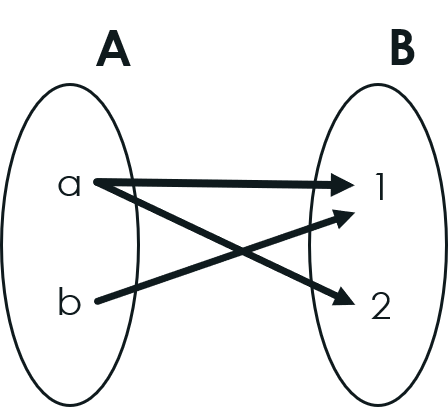
Pictorial representation of Relation R2: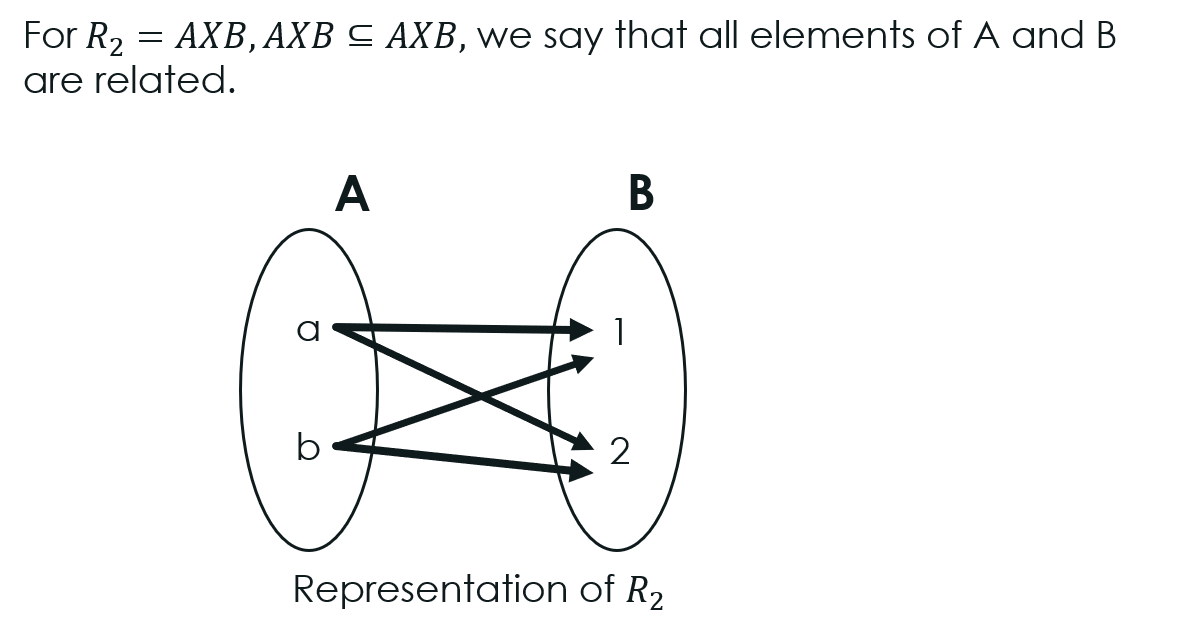
Domain of Relation R:
For a relation R subset of AXB, the subset of A which contains those elements of A which are related to some element (or elements) of B is said to be the domain of R. Symbolically,
Domain of R = {a∈A|aRb for some b∈B}
Range of Relation R:
For a relation R subset of AXB, the subset of B which contains those elements of B which are related to some element (or elements) of A is said to be the range of R. Symbolically,
Range of R = {x∈B|aRx for some a∈A}
Example:
For R1={(a,1)}⊆AXB, the domain of R1 is the singleton set {a}⊆A because b is not related to any element of B.
The range of R1 is the singleton set {1}⊆B because 2 is not related to any element of A.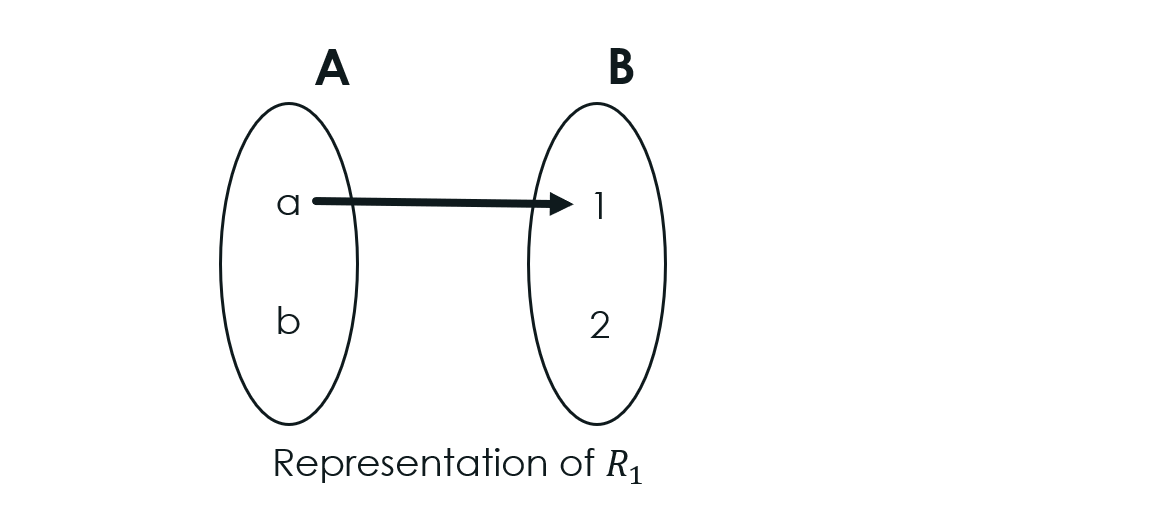
Complement of Relation R:
The relation corresponds to the complement of the subset R of AXB is said to be the complement relation of R.
If A={a, b} and B={1, 2} then
AXB={(a, 1),(a,2), (b, 1), (b, 2)}.
For, R={(a, 1),(a,2), (b, 1)} where R⊆ AXB,
Rc={(b, 2)}
is the complement relation of R.
In Rc, only b is related to 2 (bR2).
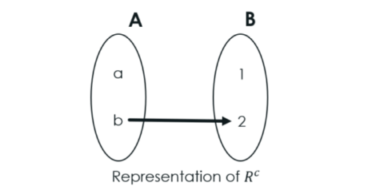
Inverse of Relation R:
The relation having the range of R as its domain and the domain of R as its range is said to be the inverse relation of R. In other words, if R is a subset of AXB then inverse of R is a subset of BXA.
If A={a, b} and B={1, 2} then
AXB={(a, 1),(a,2), (b, 1)}.
For, R={(a, 1),(a,2), (b, 1)} ⊆ AXB, A is the domain of R and B is the range of R.Then
R-1={(1, a),(2,a), (1, b)}⊆ BXA, is the inverse relation of R. For R-1, B is the domain and A is the range.
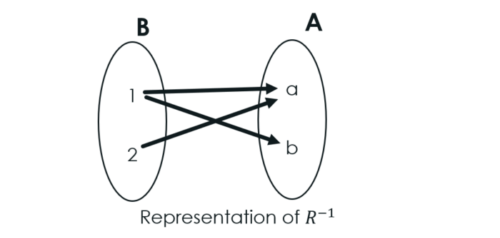
Types of Relations:
R = {(a, a), (a, b), (b, b)}
is a reflexive relation on A. ButRx={(a, b), (b, b)}
is not reflexive since for a∈A the element (a, a)∉ Rx.Suppose A = {a, b} then
R = {(a, b), (b, a)}
is a symmetric relation on A.But
Rx = {(a, b), (b, b)}
is not symmetric since for the element (a, b)∈Rx the element (b, a)∉Rx.Any relation R⊆AXA, is said to be anti-symmetric if aRb and bRa implies a=b.
Consider the set of natural numbers N = {1, 2, 3, 4, 5, …}
The relation ‘≤’ is an anti-symmetric relation on N.
For, if x ≤ y & y ≤ x then x = y.
More clearly, x is less than or equal to y and y is less than or equal to x then it is not possible for any natural number that x < y & y < x and hence implies that x = y.
Therefore, ‘≤’ is an anti-symmetric relation on N.
Any relation R⊆AXA, is said to be transitive if aRb and bRc then there must be aRc.
Equivalently, (a, b) ∈ R and (b, c) ∈ R then (a, c)∈ R.
Suppose A = {a, b, c} then
R = {(a, b), (b, c), (a, c)}
is a transitive relation on A.
But
Rx={(a, b), (b, c), (a, c), (c, a)}
is not transitive since for the pair (b, c)∈ Rx and (c, a)∈ Rx the element (b, a) ∉Rx. Also, for the pair (a, c)∈ Rx and (c, a)∈ Rx the element (a, a) ∉ Rx.
Any relation R⊆AXA, is said to be an equivalence relation on A if R is reflexive, symmetric and transitive.
Equivalently,
- (a, a) ∈ R, for every a∈A (reflexive)
- (a, b) ∈ R ⇔ (b, a) ∈ R (symmetric)
- (a, b)∈R and (b, c) ∈ R then (a, c) ∈ R (transitive)
Suppose A = {a, b} then
R = {(a, b), (a, a), (b, b), (b, a)}
is an equivalence relation on A since
- (a, a) ∈ R and (b, b) ∈R so R is reflexive
- (a, b) ∈ R implies (b, a) ∈ R & (b, a) ∈ R implies (a, b) ∈ R so R is symmetric
- (a, b) ∈ R and (b, a) ∈ R then (a, a)∈ R,
(a, b) ∈ R and (b, b) ∈ R then (a, b) ∈ R,
(a, a) ∈ R and (a, b) ∈ R then (a, b) ∈ R,
(b, a) ∈ R and (a, b) ∈ R then (b, b) ∈ R,
(b, a) ∈ R and (a, a) ∈ R then (b, a) ∈ R,
(b, b)∈ R and (b, a) ∈R then (b, a) ∈ R so R is transitive.
Therefore, R is an equivalence relation.
But
Rx={(a, b),(a, a)}
is not an equivalence relation since
(b, b) ∉ Rx hence Rx is not reflexive.
The relation which does not satisfy any one of the three conditions is not an equivalence relation where as the relation which satisfy all the three is an equivalence relation.
POSET (Partially Ordered Set):
Equivalently,
- aRa, for every a∈A (reflexive)
- aRb and bRa ⇔ a = b (anti-symmetric)
- aRb and bRc then aRc (transitive)
Then the set A together with this partial ordering R is said to be a POSET and is written as (A, R).
Example:
Consider the set of natural numbers N = {1, 2, 3, 4, 5, …} and the relation ‘≤’.
Clearly, the relation ‘≤’ is
- n≤n for any n∈ N (reflexivity)
- m≤n and n≤m ⇔ m = n (anti-symmetry)
- l≤m and m≤n then l≤n (transitivity)
Therefore, ‘≤’ is a partial ordering on N and hence (N, ‘≤’ ) is a POSET.
Maximal Element:
Minimal Element:
Bounded set:
Linearly Ordered Set or Totally ordered set:
Equivalently,
- a≤a, for every a∈A (reflexivity)
- a≤b and b≤a implies a = b (anti-symmetry)
- a≤b and b≤c then a≤c (transitivity)
- either a≤b or b≤a for any a, b∈A (comparability or trichotomy)
Then the set A together with this linear ordering (or total ordering) ‘≤’ is said to be a Linearly Ordered Set or Totally Ordered Set and is written as (A, ‘≤’).
Example:
Consider the set of integers N = {1, 2, 3, 4, 5, …} and the relation ‘≤’.
Clearly, the relation ‘≤’ is
- n≤n for any n∈ N (reflexivity)
- m≤n and n≤m ⇔ m = n (anti-symmetry)
- l≤m and m≤n then l≤n (transitivity)
- m≤n for any m,n∈ N
Therefore, ‘≤’ is a linear ordering (or total ordering) on N and hence (N, ‘≤’ ) is a linearly ordered set (or totally ordered set).